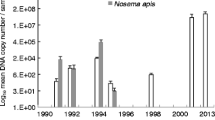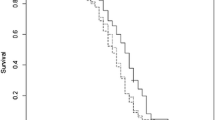Abstract
This study was conducted to determine the prevalence and infection levels of the microsporidia fungi Nosema apis and/or Nosema ceranae in honey bee colonies of two Canadian provinces. Three surveys were conducted in the springs of 2008, 2010 and 2012 and PCR identification of Nosema species were performed in samples from 169 and 181 Ontario colonies and from 76 Alberta colonies that tested positive to Nosema spp. Infection levels of positive colonies were determined by microscopy and analyzed by Nosema spp. Results showed that N. ceranae was the dominant species in all three surveys (prevalence range of 41–91 vs. 4–34 % for N. apis), whereas mixed infections were less frequent than single infections (5–25 %). Infection levels of colonies parasitized by N. ceranae were three to five times higher than those of colonies parasitized by N. apis in the three surveys whereas mixed infections showed the highest spore counts. This is the first field study demonstrating significantly higher infection levels in colonies parasitized with either N. ceranae only or with both, N. ceranae and N. apis, than in colonies parasitized with N. apis only. Taken together, these results suggest that N. ceranae may be more virulent and better adapted than N. apis in cold climates such as Canadian environments.


Similar content being viewed by others
References
Botías C, Anderson D, Meana A, Garrido-Bailón E, Martín-Hernández R, Higes M (2012) Further evidence of an oriental origin for Nosema ceranae (Microsporidia: Nosematidae). J Invertebr Pathol 110:108–113
Bourgeois A, Rinderer T, Beaman L, Danka R (2010) Genetic detection and quantification of Nosema apis and N. ceranae in the honey bee. J Invertebr Pathol 103:53–58
Calderón RA, Sánchez LA, Yáñez O, Fallas N (2008) Presence of Nosema ceranae in Africanized honey bee colonies in Costa Rica. J Apic Res 47:328–329
Chen Y, Evans JD, Simith IB, Pettis JS (2008) Nosema ceranae is a long-present and wide-spread microsporidian infection of the European honey bee (Apis mellifera) in the United States. J Invertebr Pathol 97:186–188
Copley TR, Chen H, Giovenazzo P, Houle E, Jabaji SH (2012) Prevalence and seasonality of Nosema species in Québec honey bees. Can Entomol 144:577–588
Cox-Foster DL, Conlan S, Holmes EC, Palacios G, Evans JD, Moran NA, Quan PL, Briese T, Horning M, Geiser DM, Martinson V, vanEngelsdorp D, Kalkstein AL, Drysdale A, Hui J, Zhai JH, Cui LW, Hutchinson SK, Simons JF, Egholm M, Pettis JS, Lipkin WI (2007) A metagenomic survey of microbes in honey bee colony collapse disorder. Science 318:283–287
Currie RW, Pernal SF, Guzman-Novoa E (2010) Honey bee colony losses in Canada. J Apic Res 49:104–106
Fernández JM, Puerta F, Cousinou M, Dios-Palomares R, Campano F, Redondo L (2012) Asymptomatic presence of Nosema spp. in Spanish commercial apiaries. J Invertebr Pathol 111:106–110
Ferroglio E, Zanet S, Peraldo N, Tachis E, Trisciuoglio A, Laurino D, Porporato M (2013) Nosema ceranae has been infecting honey bees Apis mellifera in Italy since at least 1993. J Apic Res 52:60–61
Forsgren E, Fries I (2010) Comparative virulence of Nosema ceranae and Nosema apis in individual European honey bees. Vet Parasitol 170:212–217
Forsgren E, Fries I (2013) Temporal study of Nosema spp. in a cold climate. Environ Microbiol Rep 5:78–82
Fries I (2010) Nosema ceranae in European honey bees (Apis mellifera). J Invertebr Pathol 103:S73–S79
Fries I, Martín-Hernández R, Meana A, García-Palencia P, Higes M (2006) Natural infections of Nosema ceranae in European honey bees. J Apic Res 45:230–233
Giersch T, Berg T, Galea F, Hornitzky M (2009) Nosema ceranae infects honey bees (Apis mellifera) and contaminates honey in Australia. Apidologie 40:117–123
Gisder S, Hedtke K, Möckel N, Frielitz NC, Linde A, Genersch E (2010) Five-year cohort study of Nosema spp. in Germany: does climate shape virulence and assertiveness of Nosema ceranae? Appl Environ Microbiol 76:3032–3038
Gómez-Moracho T, Bartolomé C, Bello X, Martín-Hernández R, Higes M, Maside X (2015) Recent worldwide expansion of Nosema ceranae (Microsporidia) in Apis mellifera populations inferred from multilocus patterns of genetic variation. Infec Genet Evol 31:87–94
Guzman-Novoa E, Eccles L, Calvete Y, McGowan J, Kelly PG, Correa-Benítez A (2010) Varroa destructor is the main culprit for the death and reduced populations of overwintered honey bee (Apis mellifera) colonies in Ontario, Canada. Apidologie 41:443–450
Guzman-Novoa E, Hamiduzzaman MM, Arechavaleta-Velasco ME, Koleoglu G, Valizadeh P, Correa-Benítez A (2011) Nosema ceranae has parasitized Africanized honey bees in Mexico since at least 2004. J Apic Res 50:167–169
Hamiduzzaman MM, Guzman-Novoa E, Goodwin PG (2010) A simple multiplex PCR assay to diagnose and quantify Nosema infections in honey bees (Apis mellifera). J Invertebr Pathol 105:151–155
Higes M, Martín-Hernández R, Meana A (2006) Nosema ceranae, a new microsporidian parasite in honeybees in Europe. J Invertebr Pathol 92:81–83
Higes M, García-Palencia P, Martín-Hernández R, Meana A (2007) Experimental infection of Apis mellifera honeybees with Nosema ceranae (Microsporidia). J Invertebr Pathol 94:211–217
Higes M, Martín-Hernández R, Botías C, Bailón E, González-Porto AV, Barrios L, del Nozal MJ, Jimenez JJ, Palencia PG, Meana A (2008) How natural infection by Nosema ceranae causes honeybee colony collapse. Environ Microbiol 10:2659–2669
Higes M, Martín-Hernández R, Garrido-Bailón E, Gonzalez-Porto AV, García-Palencia P, Meana A, del Nozal MJ, Mayo R, Bernal JL (2009) Honeybee colony collapse due to Nosema ceranae in professional apiaries. Environ Microbiol Rep 1:110–113
Huang WF, Jiang JH, Chen YW, Wang CH (2007) A Nosema ceranae isolate from the honeybee Apis mellifera. Apidologie 38:30–37
Invernizzi C, Abud C, Tomasco IH, Harriet J, Ramallo G, Campa J, Katz H, Gardiol G, Mendoza Y (2009) Presence of Nosema ceranae in honeybees (Apis mellifera) in Uruguay. J Invertebr Pathol 101:150–153
Klee J, Besana AM, Genersch E, Gisder S, Nanetti A, Tam DQ, Chin TX, Puerta F, Ruz JM, Kryger P, Message D, Hatjina F, Korpela S, Fries I, Paxton RJ (2007) Widespread dispersal of the microsporidian Nosema ceranae, an emergent pathogen of the western honey bee, Apis mellifera. J Invertebr Pathol 96:1–10
Martín-Hernández R, Meana A, Prieto L, Salvador AM, Garrido-Bailón E, Higes M (2007) Outcome of colonization of Apis mellifera by Nosema ceranae. Appl Environ Microbiol 73:6331–6338
Martín-Hernández R, Botías C, Garrido-Bailón E, Martínez-Salvador A, Prieto L, Meana A, Higes M (2012) Microsporidia infecting Apis mellifera: coexistence or competition. Is Nosema ceranae replacing Nosema apis? Environ Microbiol 14:2127–2138
Matheson A (1993) World bee health report. Bee World 74:176–212
Meixner MD, Francis RM, Gajda A, Kryger P, Andonov S, Uzunov A, Topolska G, Costa C, Amiri E, Berg S, Bienkowska M, Bouga M, Buchler R, Dyrba W, Gurgulova K, Hatjina F, Ivanova E, Janes M, Kezic N, Korpela S, Le Conte Y, Panasiuk B, Pechhacker H, Tsoktouridis G, Vaccari G, Wilde J (2014) Occurrence of parasites and pathogens in honey bee colonies used in a European genotype–environment interactions experiment. J Apic Res 53:215–219
Milbrath MO, van Tran T, Huang WF, Solter LF, Tarpy DR, Lawrence F, Huang ZY (2015) Comparative virulence and competition between Nosema apis and Nosema ceranae in honey bees (Apis mellifera). J Invertebr Pathol 125:9–15
Natsopoulou ME, McMahon DP, Doublet V, Bryden J, Paxton RJ (2015) Interspecific competition in honeybee intracellular gut parasites is asymmetric and favours the spread of an emerging infectious disease. Proc R Soc B 282:20141896
Paxton RJ (2010) Does infection by Nosema ceranae cause “Colony Collapse Disorder” in honey bees (Apis mellifera)? J Apic Res 49:80–84
Paxton RJ, Klee J, Korpela S, Fries I (2007) Nosema ceranae has infected Apis mellifera in Europe since at least 1998 and may be more virulent than Nosema apis. Apidologie 38:558–565
Shimanuki H, Knox DA (2000) Diagnosis of honey bee diseases. U.S. Department of Agriculture, Agriculture Handbook No. AH-690, Washington, DC
Stevanovic J, Stanimirovic Z, Genersch E, Kovacevic SR, Ljubenkovic J, Radakovic M, Aleksic N (2011) Dominance of Nosema ceranae in honey bees in the Balkan countries in the absence of symptoms of colony collapse disorder. Apidologie 42:49–58
Stevanovic J, Simeunovic P, Gajic B, Lakic N, Radovic D, Fries I, Stanimirovic Z (2013) Characteristics of Nosema ceranae infection in Serbian honey bee colonies. Apidologie 44:522–536
Teixeira EW, Santos LG, Sattler A, Message D, Alves ML, Martins MF, Grassi-Sella ML, Francoy TM (2013) Nosema ceranae has been present in Brazil for more than three decades infecting Africanized honey bees. J Invertebr Pathol 114:250–254
Thompson GJ, Yockey H, Lim J, Oldroyd BP (2007) Experimental manipulation of ovary activation and gene expression in honey bee (Apis mellifera) queens and workers: testing hypotheses of reproductive regulation. J Exp Zool 307:600–610
Traver BE, Fell RD (2015) A scientific note: survey for Nosema spp. in preserved Apis spp. Apidologie 46:194–196
vanEngelsdorp D, Evans JD, Saegerman C, Mullin C, Haubruge E, Nguyen BK, Frazier M, Frazier J, Cox-Foster D, Chen Y, Underwood R, Tarpy DR, Pettis JS (2009) Colony collapse disorder: a descriptive study. PLoS ONE 4:e6481
Villa JD, Bourgeois AL, Danka RG (2013) Negative evidence for effects of genetic origin of bees on Nosema ceranae, positive evidence for effects of Nosema ceranae on bees. Apidologie 44:511–518
Webster TC, Pomper KW, Hunt G, Thacker EM, Jones SC (2004) Nosema apis infection in worker and queen Apis mellifera. Apidologie 35:49–54
Williams GR, Shutler D, Burgher-MacLellan KL, Rogers REL (2014) Infra-population and community dynamics of the parasites Nosema apis and Nosema ceranae, and consequences for honey bee (Apis mellifera) hosts. PLoS ONE 9, e99465
Yoshiyama M, Kimura K (2011) Distribution of Nosema ceranae in the European honeybee, Apis mellifera in Japan. J Invertebr Pathol 106:263–267
Acknowledgements
Emma Feiler and Jessica Gu helped with microscopic detection of Nosema spp. spores as well as with spore counts. Samantha Muirhead, Lynae Vandervalk, Alexandra Panasiuk, John Williamson, Rene Burghs and Patricia Flinn collected bee samples in Alberta. Melanie Kempers, Devan Rawn and Raquel Mijares-González provided assistance in various ways. Ileana Wenger provided valuable comments that improved the manuscript. This study was partially supported by grants from the Ontario Ministry of Agriculture and Rural Affairs to EGN, the Alberta Crop Industry Fund Ltd to MN and the Canadian Agricultural Adaptation Program to LE.
Conflicts of interest
The authors declare that they have no competing interests.
Author information
Authors and Affiliations
Corresponding author
Rights and permissions
About this article
Cite this article
Emsen, B., Guzman-Novoa, E., Hamiduzzaman, M.M. et al. Higher prevalence and levels of Nosema ceranae than Nosema apis infections in Canadian honey bee colonies. Parasitol Res 115, 175–181 (2016). https://doi.org/10.1007/s00436-015-4733-3
Received:
Accepted:
Published:
Issue Date:
DOI: https://doi.org/10.1007/s00436-015-4733-3




